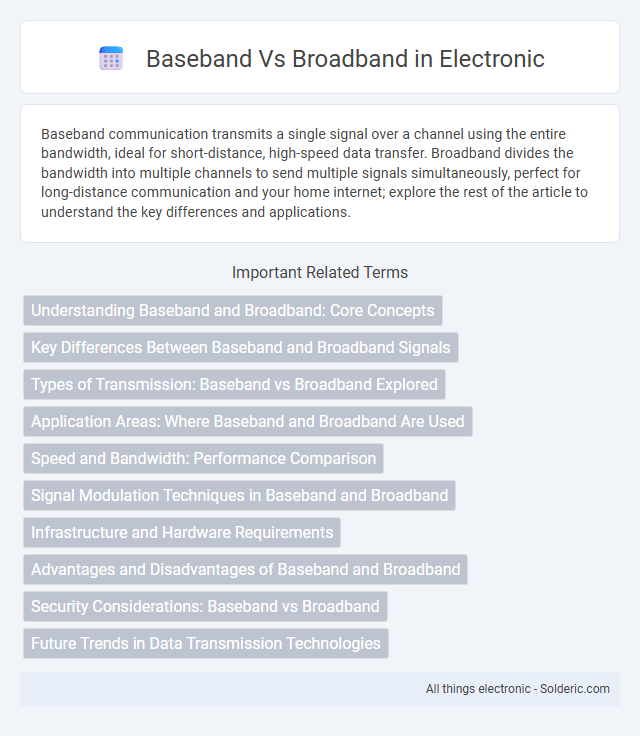Baseband communication transmits a single signal over a channel using the entire bandwidth, ideal for short-distance, high-speed data transfer. Broadband divides the bandwidth into multiple channels to send multiple signals simultaneously, perfect for long-distance communication and your home internet; explore the rest of the article to understand the key differences and applications.
Comparison Table
| Feature | Baseband | Broadband |
|---|---|---|
| Definition | Single channel transmission using the entire bandwidth | Multiple channels transmitted simultaneously over different frequencies |
| Signal Type | Digital signals | Analog signals |
| Bandwidth Usage | Uses entire bandwidth for one signal | Divides bandwidth into multiple channels |
| Transmission | Serial transmission | Parallel transmission |
| Medium | Twisted pair, Ethernet cables | Coaxial cables, fiber optics |
| Distance | Shorter distances (up to 100 meters) | Longer distances (up to several kilometers) |
| Speed | Lower data rates | Higher data rates |
| Cost | Lower implementation cost | Higher implementation cost |
| Usage | Local area networks (LANs), simple communication | Wide area networks (WANs), cable TV, internet |
Understanding Baseband and Broadband: Core Concepts
Baseband transmits digital signals over a single channel without modulation, ideal for short-distance communication like local area networks (LANs), while broadband uses multiple frequencies to transmit analog or digital signals simultaneously, supporting long-distance and high-speed internet connections. Understanding the core concepts of baseband involves recognizing its use of direct voltage pulses for signal transmission, whereas broadband employs modulation techniques such as frequency-division multiplexing (FDM) to carry multiple channels over a shared medium. Your choice between baseband and broadband depends on factors like distance, signal type, and data transmission requirements, making it essential to grasp these fundamental differences.
Key Differences Between Baseband and Broadband Signals
Baseband signals transmit digital data over a single channel using direct voltage pulses, making them ideal for short-distance communication like in Ethernet networks. Broadband signals modulate multiple frequency channels within a larger bandwidth, allowing simultaneous transmission of various signals over longer distances, such as in cable television and internet services. The key difference lies in baseband's single, low-frequency signaling versus broadband's division of bandwidth into frequency bands for multiple channels.
Types of Transmission: Baseband vs Broadband Explored
Baseband transmission sends a single signal over a medium using digital pulses, typically on twisted pair or coaxial cables, making it ideal for short-distance communication within local networks. Broadband transmission divides the medium into multiple channels, enabling simultaneous analog or digital signals over a single cable using frequency-division multiplexing, commonly applied in cable TV and internet services. Baseband offers simpler, cost-effective architecture for LANs, while broadband supports high-capacity, long-distance communication through cable modems and optical fiber networks.
Application Areas: Where Baseband and Broadband Are Used
Baseband technology is primarily used in local area networks (LANs) where data transmission occurs over a single channel, making it ideal for environments like office networks and campus settings. Broadband, on the other hand, supports multiple channels simultaneously, making it suitable for wide-area networks (WANs), cable television systems, and internet access services requiring high data rates across long distances. Telecommunication networks and internet service providers frequently employ broadband to deliver diverse multimedia content efficiently.
Speed and Bandwidth: Performance Comparison
Baseband communication transmits data over a single channel using the entire bandwidth, resulting in higher speed for short-distance communication but limited bandwidth capacity. Broadband divides the bandwidth into multiple channels, enabling simultaneous data transmission and supporting higher overall bandwidth, ideal for long-distance and multiple device connections. Your choice between baseband and broadband depends on the required speed and bandwidth performance for your network setup.
Signal Modulation Techniques in Baseband and Broadband
Baseband uses pulse code modulation (PCM) to transmit digital signals directly over a single channel without modulation, enabling high data integrity over short distances. Broadband employs frequency modulation (FM) or amplitude modulation (AM) techniques to encode multiple signals at different frequencies simultaneously, facilitating long-distance transmission and increased bandwidth utilization. The modulation methods in broadband allow for multiplexing several channels on a single medium, unlike baseband's single-channel direct transmission.
Infrastructure and Hardware Requirements
Baseband communication requires simpler infrastructure with a single channel for signal transmission, typically using twisted pair or coaxial cables and specialized network interface cards designed for digital signals. Broadband infrastructure demands more complex hardware, including frequency division multiplexers, cable modems, and coaxial or fiber optic cables capable of handling multiple channels simultaneously. The hardware for broadband supports higher data rates and simultaneous transmission of multiple signals, whereas baseband systems are optimized for short-distance, single-channel communication.
Advantages and Disadvantages of Baseband and Broadband
Baseband communication provides simple, low-cost transmission suitable for short distances, offering high data integrity and reduced interference, but it is limited by its inability to support multiple simultaneous signals. Broadband supports multiple channels over a single medium, enabling long-distance transmission and higher data rates, but involves complex infrastructure and higher costs. Understanding your network requirements can help determine whether baseband's simplicity or broadband's versatility better meets your connectivity needs.
Security Considerations: Baseband vs Broadband
Baseband communication offers enhanced security due to its point-to-point transmission, reducing exposure to external interference and eavesdropping compared to broadband systems that share frequency bands among multiple users. Broadband's multiplexing increases susceptibility to interception and requires robust encryption protocols to protect data integrity. Your choice between baseband and broadband should weigh the need for secure, direct connections against the flexibility and bandwidth advantages of broadband networks.
Future Trends in Data Transmission Technologies
Future trends in data transmission technologies emphasize the integration of broadband capabilities with advanced baseband signal processing to enhance speed and efficiency. Emerging 5G and 6G networks leverage broadband spectra for high-capacity wireless communication while utilizing sophisticated baseband algorithms to optimize signal modulation and error correction. This fusion enables ultra-low latency, massive data throughput, and improved reliability essential for applications like IoT, autonomous vehicles, and augmented reality.
Baseband vs Broadband Infographic

 solderic.com
solderic.com